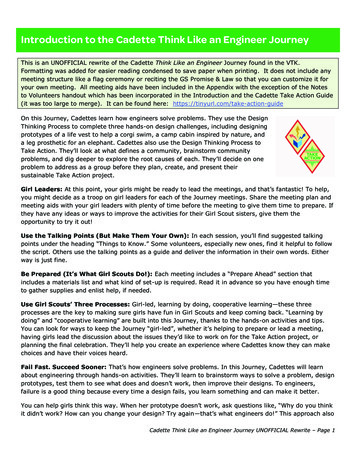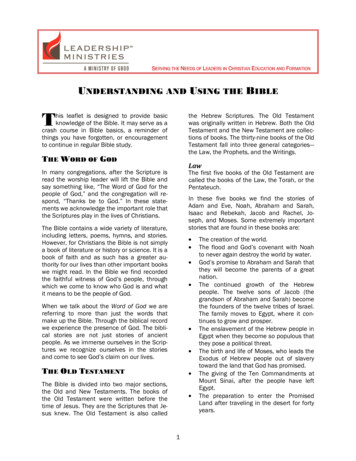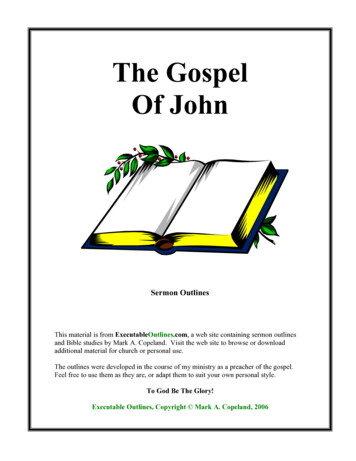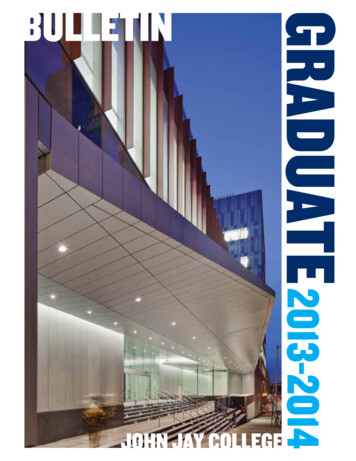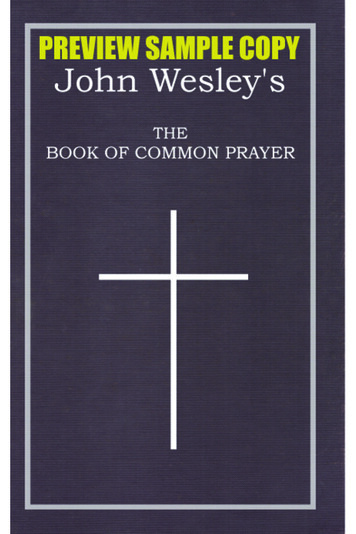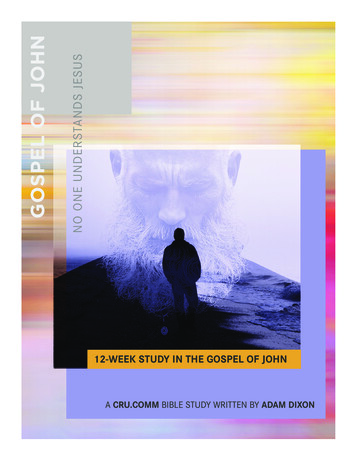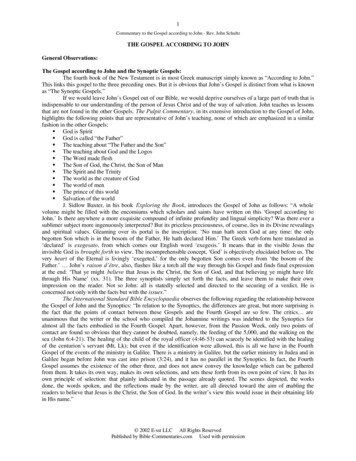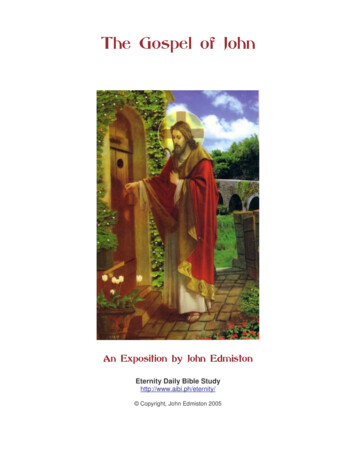
Transcription
JOURNEYTHROUGHJOHN
JOURNEYTHROUGHJOHNDEVELOPED BYAssemblies of GodNational Men’s Ministries
Scripture quotations are from the ESV Bible (The Holy Bible, English StandardVersion ), copyright 2001 by Crossway, a publishing ministry of Good NewsPublishers. Used by permission. All rights reserved. 2019 by Gospel Publishing House, 1445 N. Boonville Ave., Springfield, Missouri 65802.All rights reserved.Permission is granted for personal and local church use only.Produced in the United States of America
JOURNEYTHROUGHJOHNThe Journey BeginsThe lessons you’re about to engage are meant to help strengthen your biblicalknowledge, understanding, and application. In addition to what the Bible says,studying the culture, land, language, and other background information willproduce a broader and deeper understanding of what Scripture is saying toyou. These lessons are intended to help provide that for you.The format of these lessons is built on the following five questions that willhelp you explore the biblical author’s intent, your perspective as a modernreader, and how the Holy Spirit can apply it to you. In order to gain a fullerunderstanding of Scripture, you should ask: What did this Scripture mean to the original author and audience?What does this Scripture mean to me today?How can this Scripture apply to my life?How does this Scripture deepen my love for God?How can I demonstrate this Scripture to my family and those around me?Every lesson contains four sections that are built on the principles of thesequestions: The Author’s Lens, My Lens, The Holy Spirit’s Lens, and Upward andOutward Focus. These sections will encourage you to wrestle with the textand discover an understanding that will deepen your biblical knowledge andallow you to rightly apply what you’ve learned.These lessons have been built using several resources to provide you withan in-depth study without having to purchase every single resource. But,there are a few recommended tools for purchase that will enhance yourengagement with these lessons. They are: Fire Bible : English Standard Version JournalColored PencilsFine Point PenThe ultimate goal of these lessons is to equip you to ascertain what the HolySpirit and God’s Word is saying to you. To do that, it’s recommended that youwork slowly and methodically through this deep dive into the Scripture. 2019 by Gospel Publishing House, 1445 N. Boonville Ave., Springfield, Missouri. All rights reserved.Permission is granted for personal and local church use only.The Journey BeginsPage 4
JOURNEYTHROUGHJOHNFor Group LeadersThe lessons you’re about to engage are meant to help strengthen your biblicalknowledge, understanding, and application. In addition to what the Bible says,studying the culture, land, language, and other background information willproduce a broader and deeper understanding of what Scripture is saying toyou. These lessons are intended to help provide that for you. Determine who will be the group leader. The leader will be responsiblefor making any copies needed, coordinating meeting times, andfacilitating discussions. The group leader should select individuals to read aloud The Author’sLens and My Lens sections. Before a session begins, the group leader should read through thequestions in The Holy Spirit’s Lens section. Many lessons have morecontent than can be covered in one session, so the leader may chooseto only engage part of the questions or assign group members to workthrough part or all the questions before arrival. If your group is very large, dividing into groups of three to four people isthe best way to work through selected questions from The Holy Spirit’sLens for thirty to forty minutes. These groups should also commit towork together throughout the week. If you’ve divided into smaller groups, rejoin the entire group togetherafter that small group time. Discuss as a large group a few of theselected questions from The Holy Spirit’s Lens for ten to fifteen minutes. Finally, the leader is responsible to hold group members accountable forcompleting the Scripture reading before each session and ensuring thatthey are writing in their journals. 2019 by Gospel Publishing House, 1445 N. Boonville Ave., Springfield, Missouri. All rights reserved.Permission is granted for personal and local church use only.The Journey BeginsPage 5
JOURNEYTHROUGHJOHNLesson and ScriptureChecklist Lesson 1: Introduction Lesson 18: John 10:1–21 Lesson 2: John 1:1–18 Lesson 19: John 10:22–42 Lesson 3: John 1:19–51 Lesson 20: John 11:1–57 Lesson 4: John 2:1–25 Lesson 21: John 12:1–19 Lesson 5: John 3:1–21 Lesson 22: John 12:20–50 Lesson 6: John 3:22–36 Lesson 23: John 13:1–30 Lesson 7: John 4:1–26 Lesson 24: John 13:31–14:14 Lesson 8: John 4:27–54 Lesson 25: John 14:15–31 Lesson 9: John 5:1–30 Lesson 26: John 15:1–17 Lesson 10: John 5:31–47 Lesson 27: John 15:18–16:4 Lesson 11: John 6:1–21 Lesson 28: John 16:5–33 Lesson 12: John 6:22–71 Lesson 29: John 17:1–26 Lesson 13: John 7:1–52 Lesson 30: John 18:1–27 Lesson 14: John 8:1–11 Lesson 31: John 18:28–19:16 Lesson 15: John 8:12–30 Lesson 32: John 19:17–42 Lesson 16: John 8:31–59 Lesson 33: John 20:1–31 Lesson 17: John 9:1–41 Lesson 34: John 21:1–25 2019 by Gospel Publishing House, 1445 N. Boonville Ave., Springfield, Missouri. All rights reserved.Permission is granted for personal and local church use only.The Journey BeginsPage 6
JOURNEYTHROUGHJOHNLesson 1: Introduction Main Idea: Before you begin to chew the bite-sized pieces of thisGospel, it’s best to be familiar with the entirety of the work. This firstlesson will provide you with an overview of the entire Gospel of Johnthat will prepare you for the following lessons.The Author’s Lens (Spyglass)What did the Scripture mean to the original author andaudience? As you explore information on the author,content, culture, history, land, and language of the Bible,you will gain a better understanding of the intendedmessage of God’s Word.As you begin this study, background knowledge is helpful. Please read thepoints below. Consider the following synopsis from the Fire Bible .1 Author: John the Apostle Theme: Jesus Christ: The Son of God and Savior of People Date of Writing: AD 80–95 Background: John records much about Jesus’ ministry in Judea andJerusalem that the other three Gospels leave out, and it gives deeperinsight into the “mystery” of Jesus’ personhood as both God and man. Purpose: John 20:31 Survey: John has two major divisions.»» Chapters 1–12 describe the incarnation, introduction, and publicministry of Jesus Christ.»» Chapters 13–21 focus on the disciples as the nucleus of His newcovenant people.1 Donald C. Stamps, Fire Bible : English Standard Version , (Peabody, MA: Hendrickson Publishing, 2011), 1719–1720. 2019 by Gospel Publishing House, 1445 N. Boonville Ave., Springfield, Missouri. All rights reserved.Permission is granted for personal and local church use only.JOHN Lesson 1 IntroductionPage 1
To familiarize yourself with the geography of John:»» You may want to reference pages 114–121 of the Essential Atlas of theBible.»» Familiarize yourself with Maps number 11, 12, and 16 in the back ofyour Fire Bible . Write down thoughts or questions you would like to answer as youstudy through this book.My Lens (Eyeglasses)What does this Scripture say to you? Through studyingthe biblical explanations and principles in the text andbullet points below, you will better understand whatGod’s Word is saying to you today. Read the entire Gospel of John before the first session.»» 21 chapters, preferably three chapters a day for seven days. Read the Fire Bible chart: “The Ministry of Jesus.”»» What stands out to you from this chart?»» What is your favorite story found in John? Why? Read the Fire Bible chart: “The Miracles of Jesus.”»» What stands out to you from this chart? 2019 by Gospel Publishing House, 1445 N. Boonville Ave., Springfield, Missouri. All rights reserved.Permission is granted for personal and local church use only.JOHN Lesson 1 IntroductionPage 2
»» What miracle speaks to you most from John? Why? Read the Fire Bible three-page introduction to the Gospel of John.»» What was the most interesting thing you learned from the introduction?The Holy Spirit Lens (Magnifying Glass)How can the Scripture apply to your life? By listeningto the Holy Spirit’s leading as you answer this series ofquestions, you can gain useful insights that will help youapply the truth of God’s Word to your daily life. Highlight and write down the following in your journal as you readthrough John:»» Reoccurring words»» Places mentioned»» Names mentioned Circle the following words with the recommended colored pencils:»» “Believe” in yellow»» “Father” in orange»» “Spirit” in blue Look over your notes for John, and write down three things you hope tolearn and apply to your life as a result of this study. What thoughts came to mind as you read John this week? 2019 by Gospel Publishing House, 1445 N. Boonville Ave., Springfield, Missouri. All rights reserved.Permission is granted for personal and local church use only.JOHN Lesson 1 IntroductionPage 3
Upward and Outward FocusHow does the Scripture affect your relationship with Godand others? You experience God’s Word in action as youuse it to direct your journey with Him and those aroundyou. Answer the following questions and record theanswers in your journal. How can the study of the Gospel of John help you deepen your love ofGod? As a result of your deepened love of God, how can you practicallydemonstrate this love to others? 2019 by Gospel Publishing House, 1445 N. Boonville Ave., Springfield, Missouri. All rights reserved.Permission is granted for personal and local church use only.JOHN Lesson 1 IntroductionPage 4
JOURNEYTHROUGHJOHNLesson 2: The Word Became Flesh Main Idea: John used seven important words when describing Jesusand the effect His arrival had on the world. These words are: Word, God,life, believe, glory, grace, and truth. This lesson will take a deeper look atthese words.Scripture: John 1:1–18The Author’s Lens (Spyglass)What did the Scripture mean to the original author andaudience? As you explore information on the author,content, culture, history, land, and language of the Bible,you will gain a better understanding of the intendedmessage of God’s Word.The writer of the Gospel of John was Jesus’ disciple, John, not to be confusedwith John the Baptist who shared the common, biblical name. John wasprobably one of the youngest disciples of Jesus, and referred to himself in hiswritings as the disciple “whom Jesus loved.”John wrote his Gospel twenty to thirty years after the other three Gospelswere written. His purpose for writing is summarized in John 20:30–31 whenhe wrote, “Now Jesus did many other signs in the presence of the disciples,which are not written in this book; but these are written so that you maybelieve that Jesus is the Christ, the Son of God, and that by believing you mayhave life in his name” (ESV).In today’s lesson Scripture, John 1:1–18, the term “Word” was used four timesto describe Jesus. Though the text was also written to a Gentile audience,the Jewish readers had special insight when it came to this term. When thoseJewish readers saw the term “Word,” they likely understood this as a referenceto the Word of God that was the revelation of God himself to his people.They already possessed what we call the Old Testament, and this would haveprovided them with that insight. 2019 by Gospel Publishing House, 1445 N. Boonville Ave., Springfield, Missouri. All rights reserved.Permission is granted for personal and local church use only.JOHN Lesson 2 John 1:1–18Page 1
To the Greeks, the whole idea of logos (the Greek term translated as “Word”in John 1) meant something different. Perhaps you have heard of the Greekphilosophers Aristotle, Plato, and Socrates. Before them was anotherphilosopher who really framed Greco-Roman thought regarding creation andgods. His name was Heraclitus. He came up with the concept that above thegods was this thing called “the logos.” It was an impersonal and rational godfor the universe. So, when a Greek person heard the word logos, they thoughtof this philosophical idea. They associated logos with a purpose, reason, orrationale for the universe. So, for Heraclitus, the logos existed as a rationale forthe universe, even above the gods.Other Greek philosophers could not come to terms with the purpose of theuniverse. The Epicureans’ philosophy was that because they cannot knowand understand the purpose, they should just party because it does not makeany difference. The stoics’ philosophy was that because no one can knowthe purpose, they should go ahead and act like they know it. Neither of themreally understood the purpose of life. Even today, people are still searching forpurpose.In John 1:1, the verb used by John right before logos is in the imperfect tense.This indicates that the “Word” continually existed. When John stated thatJesus was with God, it could be better understood as Jesus being face to facewith God. This was John’s way to communicate that Jesus was not only there,but He is equal to God. He is co-eternal, co-existent, and co-equal with God.John, in essence, communicated that in the beginning there was a rationale;in the beginning, there was a reason; in the beginning, there was logic. Thenin verse four, the life that John describes is eternal life, a new dimension oflife, spiritual life, and a life better than you or I could imagine. The only way aperson could know this life is if they know the Word who came to live amonghumanity.The term translated as “believe” was also huge in John. It appears over ninetytimes. The idea that the term carried was that if you received Him, it wasbecause you believed in Him. And if you believed in Him, then you receivedHim. To paraphrase the essence of what John is communicating, one couldsay, “all the terms you can use to describe who He is, I saw. He is the God ofglory.”In this first chapter, John references several Old Testament concepts andactions that parallel the arrival of Christ in His glory. In the following chart,Keener provides an example of how the narrative echoes the giving of God’sWord, the law, through Moses:11 Craig Keener, The IVP Bible Background Commentary, (Downers Grove, IL: InterVarsity Press, 2014), 250. 2019 by Gospel Publishing House, 1445 N. Boonville Ave., Springfield, Missouri. All rights reserved.Permission is granted for personal and local church use only.JOHN Lesson 2 John 1:1–18Page 2
Exodus 33–34John 1:14–18The revelation of God’s Word, theTorahThe revelation of God’s Word, JesusGod dwelt among His people in thetabernacle (33:10); Moses pleadedthat God would continue to dwellwith them (33:14–16)The Word “dwelt” [lit. “tabernacled”]among people (1:14)Moses beheld God’s glory(33:12–23)The disciples beheld Jesus’ glory(1:14)The glory was full of grace andtruth (34:6)The glory was full of grace andtruth (1:14)The law was given through Moses(34:1–28)The law was given through Moses(1:17)No one could see all of God’s glory(33:20)No one could see all of God’s glory(1:18a), but it is fully revealed inJesus (1:18b)Taken from The IVP Bible Background Commentary: New Testament by Craig S. Keener. Copyright (c) 2014 by Craig S. Keener.Used by permission of InterVarsity Press, P.O. Box 1400, Downers Grove, IL 60515, USA. www.ivpress.comAnd finally, John’s Gospel not only proclaimed the truth about Christ, italso was combating errors and heresy. Below is a list of some challenges heattacked head-on with his writings.Errors about Jesus Christ While John Lived Some believed that Jesus was:»» A blasphemer»» Just a prophet (Gnosticism)»» A lesser godJohn was a contemporary of Cerinthus who taught that the world wascreated by lesser powers than God.2»» He distinguished between Jesus and Christ, saying Jesus was onlya man and the spirit of the divine Christ descended upon Him atbaptism and departed before the crucifixion.»» John is noted to have called Cerinthus “the enemy of truth.” Johnonce met him in a public building, and fearing the roof might fall in,John said, “Let us flee . . . for Cerinthus, the enemy of truth, is within.”2 Quentin McGhee, Gospel of John: The Word Became Flesh, (Springfield, MO: Life Publishers, 2016), 29. 2019 by Gospel Publishing House, 1445 N. Boonville Ave., Springfield, Missouri. All rights reserved.Permission is granted for personal and local church use only.JOHN Lesson 2 John 1:1–18Page 3
Docetism taught that Jesus was a divine being who only appearedhuman.»» John 1:14 refutes this error.»» Later in AD 107, Ignatius, an early church leader, exposed the heresyof Docetism.My Lens (Eyeglasses)What does this Scripture say to you? Through studyingthe biblical explanations and principles in the text andbullet points below, you will better understand whatGod’s Word is saying to you today.John 1:1–18 was Jesus’ divine genealogy. John introduced us to Jesus in theseeighteen verses. Though there are other passages of Scripture that are mucheasier to understand and apply, these verses are required for a person to havea complete theological understanding of Christ. It is good for us to take timeto think deeply about God. What you and I think of God, know of God, andunderstand of God determines the quality and the depth of our walk withGod. It is hard to walk deeply with a God of whom you know little or nothing. John wrote with the purpose that we might fully know and understandthat Jesus is the Son of God.There is a progression of signs throughout the Gospel (seeing andhearing the works of Jesus) that leads a person to decide who Jesusis and to believe. This causes the reader to enter into a whole newdimension of spiritual life.John, who is introducing us to Jesus, is communicating that Jesus isnot a lesser god, created god, or underneath the Father in terms ofHis power or His divinity. Instead, Jesus is right there with the Fatherbecause He is God (vs.1).There is nothing that came into being without the expression or creativepower of the Son of God, Jesus (vs. 3).Jesus was life and He came to show us what life is. When Jesus comesinto your life, you are moving from darkness to light because you areliving a new kind of life—a spiritual life (vs. 4–5).If a person wants to know why we exist and why we are on this earth,the answer is found in the Word (vs. 1–5).The world not only fails to recognize Jesus as Creator, but they wantnothing to do with Him (vs. 10–11). 2019 by Gospel Publishing House, 1445 N. Boonville Ave., Springfield, Missouri. All rights reserved.Permission is granted for personal and local church use only.JOHN Lesson 2 John 1:1–18Page 4
When a person puts their faith in Jesus, a wonderful expression of God’slove comes to them and they are adopted as His children (vs. 12–13).The glory of God is expressed in two ways: intrinsic (all that God is) andextrinsic (His manifested presence which is usually displayed in light)(vs. 14).To walk with Jesus can be described as grace after grace after grace(vs. 16).Jesus was the perfect balance between grace and truth (vs. 17).If you want to know what God is like, look to Jesus. If you want to knowhow God feels about things, listen to Jesus. If you want to know whatGod would do in any situation, watch Jesus. (vs. 18).The Holy Spirit Lens (Magnifying Glass)How can the Scripture apply to your life? By listeningto the Holy Spirit’s leading as you answer this series ofquestions, you can gain useful insights that will help youapply the truth of God’s Word to your daily life.Application: Write down your answer to the following questions here or in your journal:»» Who appears in this passage?»» Where is this passage taking place?»» When is this passage occurring?»» Why is this passage important?»» What is happening in this passage? 2019 by Gospel Publishing House, 1445 N. Boonville Ave., Springfield, Missouri. All rights reserved.Permission is granted for personal and local church use only.JOHN Lesson 2 John 1:1–18Page 5
»» How does this passage apply to my life? Circle and write down any reoccurring words in this passage. What verse stood out to you? Why? Review your map. (Fire Bible map numbers: 11, 12, and 16). Write down the eight descriptions of Jesus found in John 1:1–18. What canyou ascertain from these descriptions? Describe the word logos in relation to creation, life, light, and the new birth. “How would you help enlighten a person who said Jesus was created?”3 Read the Fire Bible study note on John 1:1 and answer the following:»» What is the Greek term for “Word?”»» What are the three relationships to the Word?3 Quentin McGhee, Gospel of John: The Word Became Flesh, (Springfield, MO: Life Publishers, 2016), 31. 2019 by Gospel Publishing House, 1445 N. Boonville Ave., Springfield, Missouri. All rights reserved.Permission is granted for personal and local church use only.JOHN Lesson 2 John 1:1–18Page 6
»» What did you learn from this study note? Read the Fire Bible study note on John 1:4 and answer the following:»» Describe life and light.»» What did you learn from this study note? In the following chart, summarize some concepts discussed in John 1:1–18and some of John’s other concepts throughout the rest of his 1:512:351:93:19; 12:461:114:441:133:6; 8:41–421:1412:411:14,183:16; 6:461:173:16; 4:4–42;14:61:186:46Concepts4 Quentin McGhee, Gospel of John: The Word Became Flesh (Springfield, MO: Life Publishers, 2016), 28. 2019 by Gospel Publishing House, 1445 N. Boonville Ave., Springfield, Missouri. All rights reserved.Permission is granted for personal and local church use only.JOHN Lesson 2 John 1:1–18Page 7
Upward and Outward FocusHow does the Scripture affect your relationship with Godand others? You experience God’s Word in action as youuse it to direct your journey with Him and those aroundyou. Answer the following questions and record theanswers in your journal. Take some time to listen to the Lord about the text you just studied. Howdid these verses help deepen your love of God? Write down which verse from this study that you experienced this week. As a result of your deepened love of God, how can you practicallydemonstrate the verse you experienced to your family and to othersaround you?Scripture quotations are from the ESV Bible (The Holy Bible, English Standard Version ), copyright 2001 byCrossway, a publishing ministry of Good News Publishers. Used by permission. All rights reserved. 2019 by Gospel Publishing House, 1445 N. Boonville Ave., Springfield, Missouri. All rights reserved.Permission is granted for personal and local church use only.JOHN Lesson 2 John 1:1–18Page 8
JOURNEYTHROUGHJOHNLesson 3: The Testimony of John theBaptist and Jesus Calls His Disciples Main Idea: In this lesson, John the Baptist gives insight to the witnessof Christ, a witness to the Jewish leaders, and a witness of Christ’sMessiahship. It is because of these testimonies that some of John theBaptist’s disciples follow Jesus. Finally, Jesus’ disciples demonstrate thatit’s good to introduce people to Him.Scripture: John 1:19–51The Author’s Lens (Spyglass)What did the Scripture mean to the original author andaudience? As you explore information on the author,content, culture, history, land, and language of the Bible,you will gain a better understanding of the intendedmessage of God’s Word.This section of Scripture dealt with a man whose name was John the Baptist.As was noted in the last lesson, John the Baptist is not the author of theGospel of John. The Gospel was written by John, the disciple of Jesus. It waswritten approximately twenty to thirty years after Matthew, Mark, and Lukewrote their Gospels. John wrote for the purpose that people would see the lifeand ministry of Jesus, might believe in Him, and by believing might have life inHis name.Through his introduction of Jesus in verses 1–18, the author built the case thatJesus was God. He then transitions into a discussion of John the Baptist whowas born to Zechariah, a godly priest, and his wife Elizabeth. John’s ministrybegan in the wilderness, and this would have likely had special meaning to theancient readers of this Gospel. Likely they would be able to connect the ideaof John’s ministry in the wilderness to the Exodus journey of the children ofIsrael and this new exodus that would be led by Christ. 2019 by Gospel Publishing House, 1445 N. Boonville Ave., Springfield, Missouri. All rights reserved.Permission is granted for personal and local church use only.JOHN Lesson 3 John 1:19–51Page 1
In Matthew’s Gospel, we learn that John the Baptist ate locusts and wildhoney. Some scholars have argued that the Greek word that is translated as“locust” refers to mashed up carob. Either way, it’s clear that John was eatingthe food of the poor, and as such, identified himself with the common manliving off the wild land.John the Baptist’s ministry and time on the religious scene was relativelyshort. He began ministry somewhere around AD 26, and Josephus (an ancientJewish historian) wrote that John’s ministry lasted between ten and fifteenyears. It’s also worth noting that he was six months older than Jesus and thatthey were cousins. So, their meeting in this chapter is likely not the first. Theencounter detailed in this passage took place on four different days (vs. 19, 29,35, 43), and includes the highlight of John the Baptist’s declaration of Jesusas the Lamb. John the Baptist’s allusion to the Passover lamb was in essence astatement that his audience should now look to Jesus, the Lamb of God, whowill save people from their sins.My Lens (Eyeglasses)What does this Scripture say to you? Through studyingthe biblical explanations and principles in the text andbullet points below, you will better understand whatGod’s Word is saying to you today.John the Baptist’s ministry happened mostly along the Jordan River. TheJordan River was the main river of Israel. It started above the Lake of Galilee,traveled through it, and ended at the Dead Sea. When John came on thescene, he was like a lightning bolt as he preached through this region. As thecrowds streamed to John, a dramatic turn of events happened when Jesusshowed up. This resulted in John’s declaration of Jesus as the Lamb of Godand some of John’s disciples leaving to follow Jesus. When our heart is in proper alignment, we can recognize, receive, andembrace Jesus. Humility is key to the Christian life. Be careful not to get caught up in the messenger more than theMessiah. Humility is when you and I are willing to lay down our rights and serveother people. The depth of a man is not measured by how many people he gets tofollow Christ. 2019 by Gospel Publishing House, 1445 N. Boonville Ave., Springfield, Missouri. All rights reserved.Permission is granted for personal and local church use only.JOHN Lesson 3 John 1:19–51Page 2
You need to follow where God is working in your life. As you spend time with Jesus, you realize that He is like no one youhave ever met. The power of the gospel is to transform lives. Once you have experienced a relationship with Jesus, you thinkeverybody ought to have an experience with Him (vs. 40). Jesus sees things in you that you do not see in yourself. God sees you not for what you are, but what you can become. Distractions can cause you to miss what God desires to do in you. You’re opening another avenue of communication with God when youmeditate on His Word. The Christian life is about following Jesus and walking by faith and notby sight. When you start walking like Nathanael, the power you sense as youbegin your walk with Jesus is very powerful but should continue to growdeeper (vs. 45–51).The Holy Spirit Lens (Magnifying Glass)How can the Scripture apply to your life? By listeningto the Holy Spirit’s leading as you answer this series ofquestions, you can gain useful insights that will help youapply the truth of God’s Word to your daily life.Application: Write down your answer to the following questions here or in your journal:»» Who appears in this passage?»» Where is this passage taking place?»» When is this passage occurring?»» Why is this passage important? 2019 by Gospel Publishing House, 1445 N. Boonville Ave., Springfield, Missouri. All rights reserved.Permission is granted for personal and local church use only.JOHN Lesson 3 John 1:19–51Page 3
»» What is happening in this passage?»» How does this passage apply to my life? Circle and write down any reoccurring words in this passage. What verse stood out to you? Why? Review your map. (Fire Bible map numbers: 11, 12, and 16). Write down the thirteen descriptions of Jesus found in John 1:21–51. Whatcan you gather from these descriptions? Explain John the Baptist’s response on his relationship to Jesus. 2019 by Gospel Publishing House, 1445 N. Boonville Ave., Springfield, Missouri. All rights reserved.Permission is granted for personal and local church use only.JOHN Lesson 3 John 1:19–51Page 4
How is Jesus being described as the Lamb of God, different from otherreligious leaders? Of the five disciples called to follow Jesus, who you are most like and why? Read the Fire Bible study note about John 1:29 and answer the following:»» Describe the correlation between the Passover lamb (Exodus 12:3–17)and Jesus.»» Why do you think Jesus became our ultimate sacrifice? Read the study note about John 1:51 in your Fire Bible . What are yourthoughts on the comparison of Jesus to a ladder? 2019 by Gospel Publishing House, 1445 N. Boonville Ave., Springfield, Missouri. All rights reserved.Permission is granted for personal and local church use only.JOHN Lesson 3 John 1:19–51Page 5
In the following chart, summarize some concepts discussed in John 1:1–18and some of John’s other concepts through
with John the Baptist who shared the common, biblical name. John was probably one of the youngest disciples of Jesus, and referred to himself in his writings as the disciple “whom Jesus loved.” John wrote his Gospel twenty to thirty years after the other three Gospels were written. His purpose for wri
